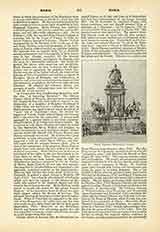

Margaret of Lorraine, BLESSED, Duchess d’Alencon, religious of the order of Poor Clares, born in 1463 at the castle of Vaudemont (Lorraine); died at Argentan (Brittany) November 2, 1521. The daughter of Ferri de Vaudemont anti of Yolande d’Anjou, little Margaret became an orphan at an early age and was brought up at Aix-en-Provence, by King Rene of Anjou, her grandfather. The latter dying in 1480 she was sent back to Lorraine to her brother, Rene II, who gave her in marriage at Paris, in 1488, to the Duke d’Alengon. Left a widow in 1492 she busied herself in the administration of her duchy and the education of her children. When she was relieved of the duties imposed on her by her position she decided to renounce the world and retired to Mortagne, to a monastery of religious women who followed the rule of Saint Elizabeth. Later having brought with her to Argentan some of these nuns she founded there another monastery which she placed, with the authorization of the pope, under the rule of Saint Clare, modified by the Minor Observants. She her-self took the religious habit in this house and made her vows on October 11, 1520, but on November 2, 1521 after having lived for a year in the most humble and austere manner, she died a most holy death in her modest cell at the age of sixty-two. Her body, preserved in the monastery of the Poor Clares, was transferred when that monastery was suppressed to the church of St. Germain d’Argentan, but in 1793 it was profaned and thrown into the common burying-place.
The memory of Margaret of Lorraine is preserved in the “Martyrologium Franciscanum” and in the “Martyrologium gallicanum”. After an invitation made by the Bishop of Seez, Jacques Camus de Pontcarre, Louis XIII begged Pope Urban VIII to order a canonical inquiry into the virtues and the miracles of the pious Duchess d’Alencon; unfortunately in the political agitations of the time the realization of this plan was lost sight of. At the initiative of the present Bishop of Seez an effort is being made to obtain recognition at the Court of Rome of her cultus. The process is well on its way.
LEON CLUGNET

